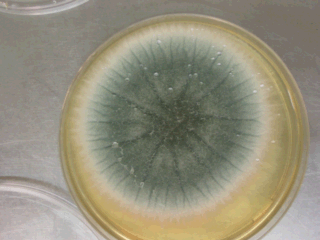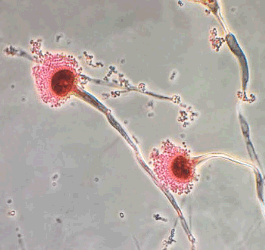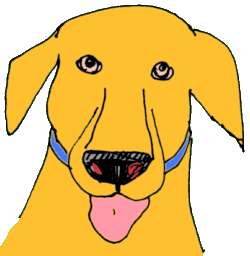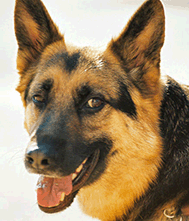|
Aspergillus

ASPERGILLOSIS

Culture sample of Aspergillus fumigatus
(Photocredit: Jankaan via Wikimedia Commons)
|
Fungi of the Aspergillus genus are well known to most people as the lacy, fluffy mold that grows on foods kept a bit too long. There are over 180 species of Aspergillus fungi and they generally do not cause disease unless the host has a compromised immune system or gets a very big exposure to the fungus. The most common species to cause problems in veterinary patients are Aspergillus fumigatus (which typically infects the nose and nasal passages) and Aspergillus tereus (which causes systemic/whole body disease). |

Aspergillus fumigatus under the microscope
(Photo credit: CDC Public Health Image Library) |
Under the microscope Aspergillus looks like a beautiful flower
but note the spores (called “conidia”) it sheds.
These float in the air to colonize organic matter
or infect a host when they land.
|
SINONASAL (NOSE) ASPERGILLOSIS
|
Sinonasal aspergillosis is the most common type of Aspergillus infection. Sinonasal infections can be very invasive or less invasive, the very invasive kind unfortunately being much more common. Invasive infections actually destroy the delilcate bones of the nasal sinuses while the less invasive infections involve the formation of a big mucous wad of fungus called a "fungal ball" or "aspergilloma." Advanced imaging can detect either of these but more on that later. What the owner usually sees is a snotty nasal discharge that often stinks, lasts for months, does not respond to antibiotics, and classically only comes from one nostril. Nose bleeds occur intermittently and the edges of the nostrils are often ulcerated. Both the more invasive and less invasive forms create similar symtoms; it is imaging and/or rhinoscopy that usually tells them apart and sometimes they occur together.
Classically, the affected dog is of a breed with a long nose (collie, greyhound, dachshund etc.) though in one study, retrievers and rottweilers showed highest numbers (possibly suggesting they do more sniffing in fungal contaminated areas). Any age dog could be come infected though aspergillus infection is unusual in dogs under age 1 year.
|

Instead of healthy pink mucosa, the
inside of the nostril may look raw.
(Original graphic by marvistavet.com)
|
To diagnose sinonasal aspergillosis two out of the following criteria must be met:
- Imaging (ideally CT or MRI) should be compatible with a fungal infection. This means bone destruction is visible. Radiographs can also be used but CT and MRI offer superior imaging.
- Fungal colonies should be visible with rhinoscopy (a technique where a narrow needlelike camera is inserted in the nose).
- Aspergillus organisms are seen in (or cultured from) either a tissue biopsy or the nasal discharge.
- A positive test is found for a substance in the fungal cell wall called "galatomannan." Galactomannan can be detected in either blood or urine. Another blood (such as antibody tests against Aspergillus species) could be used as a criterion but the galactomannan tests seem to be more accurate.
A typical approach to a dog with a nasal discharge suggestive of fungal infection will likely involve imaging, followed by rhinoscopy. General anesthesia is needed for both of these procedures and referral is likely to be recommended as specialized equipment will likely be necessary.
The treatment of aspergillosis has been challenging for many years; fungal infections as a rule are slow to clear and for a long time the only available drugs had toxic side effects. Today, sinonasal aspergillosis has a good prognosis thanks to a unique treatment plan. The patient is anesthetized and the back of the throat and is closed off with gauze and inflatable balloon catheters called “foley catheters.” The nostrils are also closed off (the patient breathes through an endotracheal tube that is placed through the mouth) and a 1% solution of clotrimazole, a topical antifungal lotion, is infused into the nose and frontal sinuses. The solution incubates for an hour and the patient is periodically turned to be sure all the nooks and crannies of the sinuses are treated. At the end of the incubation, the clotrimazole is drained through the nostrils and suctioned out.
This treatment is highly effective, with an 86% success rate though about 1/3 of patients require several treatments. Most of the time the nasal discharge has resolved within a couple of weeks but if there is still evidence of continuing infection one month after the treatment, the patient should be rechecked and another of bout of treatment will most likely be needed.
If there is evidence that the infection has eroded through the sinus bones and has penetrated the brain, the treatment described above cannot be used and oral medication is needed. Common medications used are itraconazole and fluconazole. Several months of therapy is needed and a 60-70% success rate has been reported.
DISSEMINATED ASPERGILLOSIS
|
As shown in the picture above, Aspergillus fungi shed microscopic spores which float in the air and which we inhale all the time. Fortunately, we have an assortment of safety mechanisms built into our bodies which prevent infection (sinuses to trap inhaled debris, ability to sneeze, mucus lining of the entire respiratory tract to trap debris, cilia to remove mucus with trapped debris, and an immune system to fight infection). If Aspergillus spores, called “conidia,” escape these mechanisms and begin to grow, they become more difficult for the body to remove. In disseminated aspergillosis, the fungus penetrates the respiratory tract and may travel to other organs via the bloodstream, creating a more serious fungal invasion. German shepherd dogs seem to be predisposed to this type of dissemination.
Symptoms experienced by the patient depend on where the fungus settles. Bone infection is common and the intervertebral discs of the spine also tend to be favorite spots for Aspergillus. This means that clinical features commonly include lameness, weakness, and incoordination. Frequently there are draining tracts (holes with pus or bloody discharge oozing out) in the areas of infection. Fever, weight loss, appetite loss, and uveitis (deep inflammation of the eye) are also features. Sadly, most dogs are already terminally ill by the time they are first examined.
|
 German shepherd dogs seemed to be German shepherd dogs seemed to be
more susceptible to disseminated aspergillosis.
(Photocredit: Morguefile.com) |
Diagnosis is tricky. Bone destruction patterns on radiographs may be suggestive of fungal infection. If one is lucky, the organism can be identified in some of the draining fluid or in a tissue sample. If the organism is not visible, it may be cultured from fluid or tissue sample or detected on a tissue biopsy. The tests for Aspergillus cell wall galactomannan as described above may be helpful in making this diagnosis.
Treatment is particularly frustrating for disseminated aspergillosis. At present, posaconazole seems to be the best choice but years of treatment are likely required (very likely the medication will be for life) and many dogs still die of their disease before the medication can get the condition controlled. If the body part involved can be surgically removed (such as amputation of a bone), this can be curative and, as distasteful as it may sound, aggressive surgery could be a dog's only chance of survival.

Page last updated 1/29/09
Page last reviewed: 9/7/2025
|